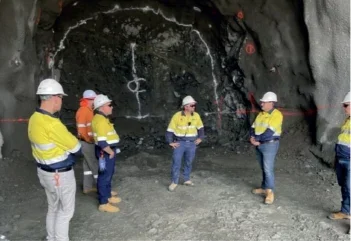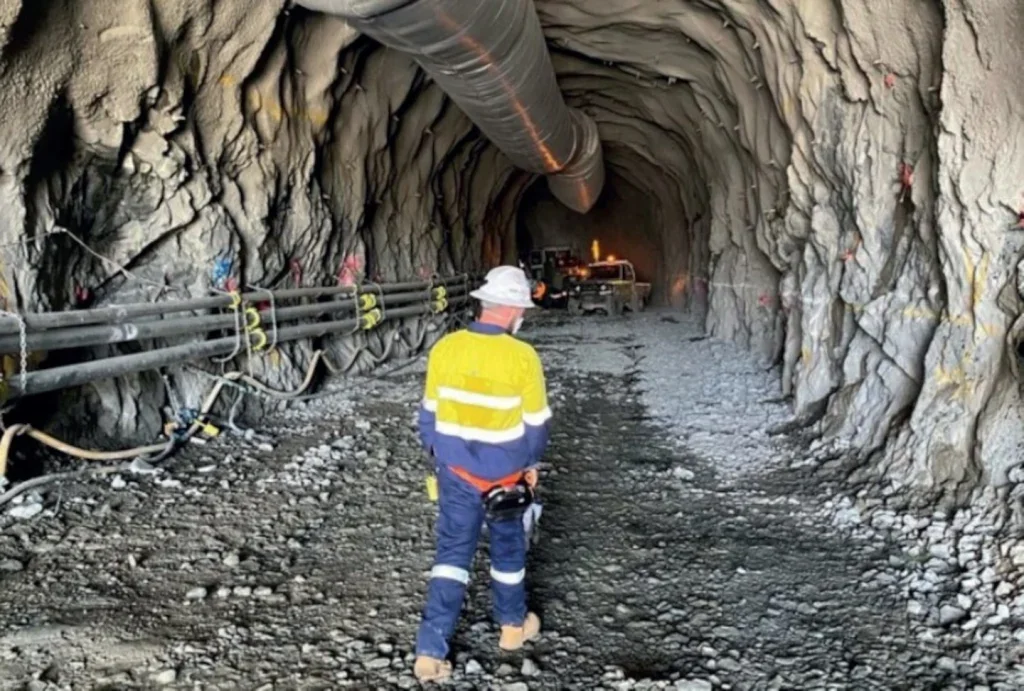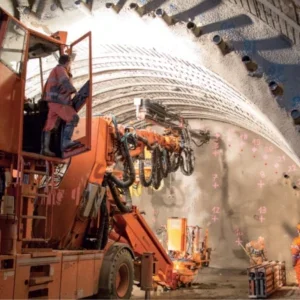
The 250MW Kidston pumped storage project is currently under construction and will be the first pumped hydro project in Australia for over 40 years. It will also be the first to be developed by the private sector and the third largest electricity storage device in the country.
Forming part of the Kidston Clean Energy Hub in North Queensland, it also comprises a solar and wind power project.
Genex Power, the company which owns the project, recently discussed the lessons it has learnt with respect to the excavation of the project’s shafts.
Four shafts are required to be excavated:
- Ventilation Shaft – 4.1m-diameter (excavated), 243m deep.
- Cable Shaft – 4.1m-diameter (excavated); 252m deep.
- Intake Shafts x 2 – 5m-diameter (excavated); 244m deep.
Raisebore techniques were used to sink the shafts, with the shafts excavated from the bottom up. This was made possible due to the availability of underground caverns prior to excavation commencing. The general methodology followed was:
- Establishment and survey.
- Installation of pilot hole.
- Attachment of cutterhead and ream the shaft towards the surface.
- Removal of cutterhead and dis-establishment.
Genex discussed various key challenges and lessons learned relating to the raisebore operations and focused on ground conditions, the pilot hole, and reamer operations and removal.
GROUND CONDITIONS
During raisebore operations, the excavated shaft is an unsupported circular profile, and support can only be given once the reaming operations are complete. Raisebore shaft construction techniques are normally adopted where ground conditions are favourable, access is provided to the shaft bottom, and the project shaft diameter and length are deemed as being suitable for the equipment available. Where the ground conditions are less stable and at risk of collapse/ravelling, then structural ground support treatment is required.

Following a comprehensive geotechnical investigation, Genex identified that all four shafts would encounter competent rock, with the exception of the top 20m of ground for the ventilation and cable shaft locations where extremely weathered rock was found. This could result in potential ground squeeze, ravelling and stability issues if left unsupported.
As such, the project commenced the installation of a secant piled ring in the upper zone of both the ventilation and cable shafts as an advanced pre-sink activity to the raisebore operations. This activity was not included as part of the original scope of works as the geotechnical information needed to be confirmed. Further geotechnical information obtained during detailed design confirmed the need for pre-sink piles.
Genex says the lesson learnt here highlights the importance of good geotechnical investigation and analysis to make informed decisions on ground treatments and supports. This was a known risk at the Kidston Project and was confirmed and addressed prior to raisebore operations commencing.
PILOT HOLE
The pilot hole links the top and bottom of the shaft and ultimately sets the shaft alignment. Ensuring verticality when drilling the pilot hole is of utmost importance. At Kidston, the pilot hole for each shaft was drilled using the rotary vertical drilling system.
The pilot hole within the cable shaft encountered a rogue geotechnical monitoring instrument at depth, which twisted around the drill head and affected the verticality of the hole, and in turn the shaft. This was remedied by removing the pilot hole drill rods, clearing the drill bit, and recommencing pilot hole drilling.
The lesson learnt relates to ensuring that the utilisation of state-of-the-art positioning and drilling equipment will provide the greatest chance of shaft verticality. Genex says that other methods are available but for the Kidston Project, verticality was paramount and would not have been achieved without the use of the rotary vertical drilling system.
Reaming operations and removal
Once the cutter head is in action it is critical to ensure that for safe operation the cuttings are free to fall to the base of the shaft and removed frequently to make sure they don’t block the shaft opening. In previous projects shafts have choked and resulted in the uncontrolled movement of cuttings into the bottom of the shaft, filling the underground works with such force that equipment has been known to be transported up the tunnel drive.
The Genex report highlights that good communication between underground and raise bore teams is critical during reaming operations. The appropriate methodology and safety provisions are also required to facilitate removal of the reamer head at the surface. This minimises time and cost as opposed to attempting to lower the reamer head to an underground chamber because, at a depth of 250m, the reattachment of drilling strings to lower and then the subsequent removal of these is time-consuming.
KIDSTON PUMPED STORAGE: KEY FACTS
The 250MW Kidston Pumped Storage Hydro Project (K2-Hydro) is a landmark renewable energy project and the centerpiece of the Kidston Clean Energy Hub in Far-North Queensland, Australia.
This project is a critical component in Australia’s shift towards renewable energy, designed to generate, store, and dispatch power during peak demand periods.
Key Features
- Nameplate Capacity: 250MW
- Storage Capacity: 2,000MWh (8 hours of continuous generation)
- Start-Up Time: Less than 30 seconds
- Lifespan: 80 years
- Water Head: 218m (max) – 181m (min)
- Turbines: 2 reversible turbines (125MW each)
- Upper Reservoir: Wises Pit (52 hectares)
- Lower Reservoir: Eldridge Pit (54 hectares)
The Kidston Pumped Hydro Project is the world’s first to repurpose an abandoned gold mine, utilising Wises and Eldridge pits as its upper and lower reservoirs.
This innovative approach to energy storage taken at the Kidston project reduces capital expenditure by reusing existing mining infrastructure, such as an accommodation camp, airstrip, and water supply systems, resulting in faster construction and lower costs. The Copperfield Dam provides a stable water source for the hydro system via an existing pipeline, further minimising additional infrastructure needs.
The project is also integrated into the larger Kidston Clean Energy Hub, which combines large-scale solar, wind energy, and pumped storage hydro. This integration allows for efficient energy generation, storage, and dispatch, providing reliable renewable energy on demand, especially during peak periods. A dedicated transmission line will connect the hub to the National Electricity Market (NEM), enhancing the stability of North Queensland’s grid and providing muchneeded system strength.
Financially, the project reached contractual close in April 2021, with construction starting in May 2021. The total construction cost is approximately A$777 million, backed by a robust funding package. A 15-year, A$610 million debt facility was secured from the Northern Australia Infrastructure Facility, alongside a A$47 million grant from the Australian Renewable Energy Agency (ARENA), and an additional A$3 million of subordinated debt from the Clean Energy Finance Corporation. The project is set for completion by 2025.
The economic benefits of the project are considerable, with 900 direct jobs created during the construction phase. Additionally, the project will help Queensland meet its Renewable Energy Targets of 70% by 2032 and 80% by 2035, playing a vital role in Australia’s clean energy future. By combining innovation, integration, and economic value, K2-Hydro is a model for future renewable energy developments.
The project is being delivered by leading contractors McConnell Dowell and John Holland, with Entura providing engineering consultancy.






